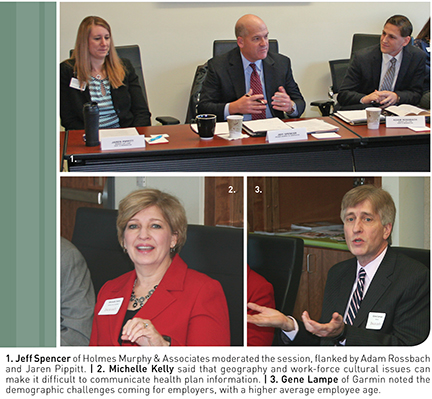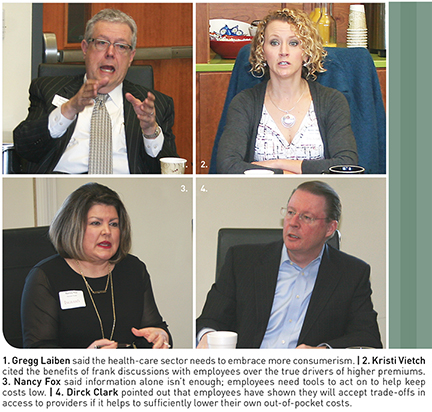HOME | ABOUT US | MEDIA KIT | CONTACT US | INQUIRE
HOME | ABOUT US | MEDIA KIT | CONTACT US | INQUIRE

Participants (from left): Matt Wheeler, Holmes Murphy & Associates; Gregg Laiben, Blue Cross Blue Shield of Kansas City; Michelle Kelly, Kansas City Southern Railway Co.; Joe Sweeney, Ingram’s; Dirck Clark, MPact Health; Kristi Vietch, Intouch Solutions; Jaren Pippitt, Mosaic Life Care; Marcie Wibright, Bank Midwest; Adam Rossbach, Mosaic Life Care; Gene Lampe, Garmin; Jeff Spencer, Holmes Murphy & Associates; Nancy Fox, Triumph Foods;

Are double-digit increases in employer-paid health-insurance premiums simply a fact of business life?
If you answered “yes” to that question, you might want to consider what corporate benefits administrators, insurance brokers and insurers have to say on that topic. They’ll tell you that the challenge of controlling costs is profound, but by no means insurmountable. There are ways to hold the line. But more than that, there are ways to save and still come out ahead with employee engagement, loyalty and job satisfaction.
So said a dozen executives from different health-care disciplines who on Jan. 28 descended on Mosaic Life Care at Shoal Creek, a pristine setting of offices, treatment rooms, labs and meeting space, all dovetailing with the health-care provider’s vision of what a patient-centered medical home should look like.
They gathered for a two-hour discussion on the current state of health-care benefits design and administration, the second of three events stemming from a collaboration between Mosaic Life Care and Ingram’s to explore the larger issues facing employers who provide health-insurance benefits for their workers. And those issues, while grounded in containing costs of rising premiums, go far beyond the impact of those costs to the bottom line. A healthier work force is more productive, more stable and more engaged, studies show, all of which contribute to improved organizational performance.
In addition to exploring strategies for lowering employer health-care costs, this particular roundtable covered consumer attitudes and behaviors, the effects of integrated health care and record-keeping, and the communication challenges posed to benefit-plan administrators. The session was co-chaired by Adam Rossbach, Mosaic Life Care’s vice president for strategic business solutions, and Jaren Pippitt, the company’s home-centric administrator. Jeff Spencer of Holmes Murphy & Associates, served as the moderator. The first question for the group called for a simple assess-ment of a highly complex health-care environment: What’s working?
Gregg Laiben of Blue Cross Blue Shield of Kansas City immediately recognized the transformation among employers in the region. “One thing going well is the acceptance in the employer community of the importance of wellness, creating a healthy work force, maximizing productivity and reducing future costs,” he said. However, there are concerns about costs in general, and pharmaceutical costs in particular.
Jaren Pippitt also sees the interests of employers “to do something different. We get requests every day to talk about potential solutions. They are listening to their employees and trying to bring different solutions to them.”
 Michelle Kelly of Kansas City Southern Railway noted some progress in managing costs, but was more concerned about the trends they see in predictive claims. “Blood pressure, diabetes and musculoskeletal issues are trending at a very high rate” within the rail company’s work force, she said.
Michelle Kelly of Kansas City Southern Railway noted some progress in managing costs, but was more concerned about the trends they see in predictive claims. “Blood pressure, diabetes and musculoskeletal issues are trending at a very high rate” within the rail company’s work force, she said.
Garmin’s Gene Lampe identified demographics as a looming challenge. “As business grow and as they hire more, the average age continues to go up, and that drives medical costs,” he said.
One significant shift seen—at Intouch Solutions, anyway—is that employees are developing a greater awareness of both the costs of their benefit plans to themselves and the company. “People ask great, thoughtful questions,” said Kristi Vietch. “They understand the reason why premiums are going up. “
One welcome change, said Triumph Foods’ Nancy Fox, is the expansion of creative ideas coming out of the provider community. “From where we were five years ago, it’s mind-boggling,” she said. At the same time, employee education, includ-ing that of executives, must be improved. And the communication piece will remain a challenge for manufacturers in particular, she said; Triumph has employees who speak 25 languages, so “we struggle to communicate on the common things about business.”
A tactic that has paid significant dividends for Bank Midwest, said Marcie Wibright, was the move to self-insurer status. “We’ve taken an aggressive approach to managing our risk pool and those causing the cost increases are the ones carrying most of that burden,” she said. Shifting away from one or two high claimants dropped costs $1.2 million the first year, she said, without truly significant premium changes for them.
Addressing shared con-cerns about pharmacy costs, Gregg Laiben noted the role that technology is playing in segmenting health-care delivery. An office visit with a physician can be done remotely, he said; the dynamic changes when it comes to prescribing drugs, a process that can be abused by those who know how to use technology to do so. “It really is a different way of practicing medicine,” he said, “and as the laws change, we’re going to have to stumble through some things.”
Participants also explored the advantages presented by resources like on-site mobile clinics, integrated care, telemedicine and pharmacy delivery. But all of those tools, Nancy Fox noted, are addres-sing only part of the issue.
“At the root of a lot of chronic conditions, or those that become catalysts, is someone not taking care of themselves because they have a schedule that doesn’t allow it,” she said. Those tools can help with management of chronic conditions.
Laiben noted that a dash of consumerism could help, as well. Too many people insured through their employers don’t know how much their care is truly costing. “We need to apply many more consumerism principals,” he said.
Dirck Clark noted the success of MPact Health, a collaboration that operates like an accountable-care organization, and one owned by Mosaic Life Care, Mercy Health System and the University of Missouri. Last year, the MU system offered a narrower provider network, at lower costs, and more than twice as many MU employees as anticipated signed up for that coverage, saving roughly 15 percent.
That might be a more attractive option where employees already pay a bigger share of their own health-insurance costs. But at Garmin, said Gene Lampe, “our problem was, we have a 90/10 cost share, so there’s not a lot of room to maneuver there.”

Matt Wheeler cited the challenge of the Kansas City marketplace, which was effectively one network—all payers had, basically, the same providers. “Maybe that hasn’t been the most efficient way to contract,” he said. “A sub-network can help stem that tide, but it definitely comes with some sacrifice.”
Nancy Fox said that providers are far less rigid in their practices today, and more willing to engage in conversations about cost structures, recognizing that not one size fits all. But a plan that works for Sprint, she said, might never work for a manufacturing company. “You have to understand your patient population and where the costs are coming from,” she said. “We’re not just interested in reducing costs—well, we are; we’re not mad at money—but the way to do that is to make people healthier.”
Fortunately, said Matt Wheeler, we’ve reached a point where “employees are hungry for a change.” But even for those who are willing to take responsibility for their health, the effects can be discouraging. “You can do all the right things as an employer, and yet you’re still facing nasty increases (for premiums). That’s where the frustration is.”
Part of the challenge in expanding the wellness piece at work, said Michelle Kelly, is that “health care is very personal to people.” The key, she said, is providing the right program, driving people to it, and shifting the employer health concern to being health-driven, rather than sickness-driven. “We’re treating people when they get sick, but not providing them with the resources” to prevent much of that sickness, she said.
“What we need to focus on as employers is getting engagement vs. compliance,” said Gene Lampe. Employees who go through biometric screening, he said, can get information about their health, but often don’t have tools on how to put it to effective use. “It goes back to building a culture of health in your organization, where people recognize that it’s not OK to bring doughnuts to your meeting.”
Kristi Vietch cited the benefits of ensuring that employees had information that helps them understand why costs are moving the direction they are, and how each one of them can influence that trend line. “If there is a reason we have to shift costs, we explain it,” she said. “We show them how we tweaked thing to get a lower percentage increase.” Employees understand that, and it builds on the trust factor, she says. “ ‘We know you’re looking out for us, and we appreciate it.’ ”
As with car insurance, said Nancy Fox, if “you go back to the model where employees are in control of what’s being spent, that helps them to be better consumers. But you have to give them tools, too. Their responsibility is to ask that provider, ‘do I really need that MRI after I just had one last week’.” High-deductible plans, she said, encourage that kind of consumerism.
A high-touch plan, said Marcie Wibright, also helps. During Bank Midwest’s transition to self-insurer, she said, “we called every single associate to help them understand the why, and that how they manage their own care impacts what our premiums are every year.
When Kansas City Southern employees began to realize that the company was their health insurer, rather than an insurance provider, it changed the way they viewed things. “They became more thoughtful about spending the company’s money,” she said.
One thing employers can expect, said Gregg Laiben, is a continuing explosion in technology, which will impact delivery and access. “The next five years are going to be extremely exciting in health care,” he said. “Hospitals and clinics are conservative groups, but they are willing to change, albeit slowly, and as carriers and employers, we’ve got to push them to do that.”